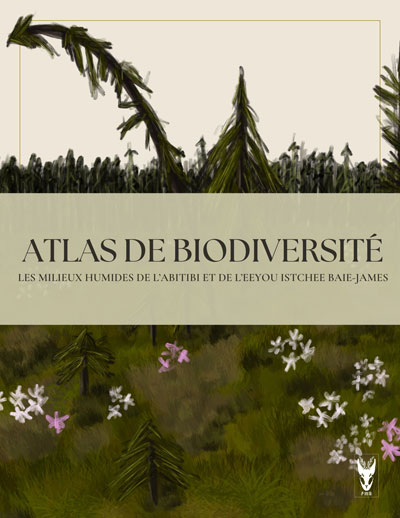
Marc-André Villard
Membre associé
Écologie animale/Conservation
Professeur associé
Université du Québec à Rimouski
Département des sciences biologiques
300 Allée des Ursulines, C. P. 3300, succ. A
Rimouski, QC, Canada, G5L 3A1
Tel : 418-723-1986 poste 1540
FORMATION
- Postdoctorats en biologie (Brigham Young University/University of Alberta)
- Ph.D. en écologie des paysages, 1991 (Carleton University)
- B.Sc. en sciences biologiques, 1986 (Université de Montréal)
THÈMES DE RECHERCHE
Réponse démographique des oiseaux à l’aménagement forestier intensif
L’exploitation forestière sous toutes ses formes s’accompagne d’une altération de la qualité des habitats à l’échelle locale (peuplement) et d’une modification de la structure des paysages. La réponse numérique de différentes espèces indicatrices est souvent mesurée, mais mes étudiants et moi nous intéressons également aux processus qui sous-tendent cette réponse à l’intensité de l’aménagement forestier. Les techniques utilisées comprennent la cartographie des territoires, le baguage et le suivi télémétrique.
Pour plus de détails:
- Haché, S., Cameron, R., Villard, M.-A., Bayne, E.M. et MacLean, D.A. 2016. Demographic response of a Neotropical migrant songbird to forest management and climate change scenarios. Forest Ecology and Management 359: 309-320.
- Vernouillet, A., Villard, M.-A. et Haché, S. 2014. ENSO, nest predation risk, food abundance, and male status fail to explain annual variations in the apparent survival rate of a migratory songbird. PLOS ONE 9(11): e113844.
- Haché, S., Bayne, E.M. et Villard, M.-A. 2014. Post-harvest regeneration, sciurid abundance, and postfledging survival and movements in an Ovenbird population. Condor 116: 102-112.
- Haché, S., Pétry, T. et Villard, M.-A. 2013. Temporal changes in the numerical response of breeding birds to experimental selection harvesting in a northern hardwood forest. Avian Conservation and Ecology 8(1): 4.
- Thériault, S., Villard, M.-A. et Haché, S. 2012. Habitat selection in site-faithful ovenbirds and recruits in the absence of experimental attraction. Behavioral Ecology 23: 1289-1295.
- Haché, S. et Villard, M.-A. 2010. Age-specific response of a migratory bird to an experimental alteration of its habitat. Journal of Animal Ecology 79: 897-905.
- Poulin, J.-F., Villard, M.-A. et Haché, S. 2010. Short-term demographic response of the brown creeper to experimental selection harvesting. Écoscience 17: 20-27.
Connectivité fonctionnelle dans les paysages forestiers fragmentés
On présume souvent que les oiseaux peuvent coloniser et saturer l’habitat propice sans difficulté. Certaines études suggèrent en effet que les passereaux peuvent franchir des dizaines ou des centaines de kilomètres durant leur phase de dispersion (ex. Tittler et al. 2006, 2009). Or, des études expérimentales suggèrent que les oiseaux forestiers évitent de se déplacer en milieu inhospitalier (coupes à blanc, plantations de conifères), s’ils en ont le choix. Mes étudiants et moi étudions les facteurs qui peuvent influencer les décisions des oiseaux forestiers en mouvement dans différents types de paysages. Pour ce faire, nous utilisons des approches directes (baguage, télémétrie, translocations) ou indirectes (signatures isotopiques). S’il s’avère que même des organismes comme les oiseaux ne peuvent se disperser efficacement sous certaines conditions (ex. : habitat morcelé par l’aménagement forestier intensif), plusieurs autres taxons risquent aussi d’être très sensibles à la fragmentation de leur habitat. Les oiseaux se prêtent bien à un suivi intensif car ils sont relativement faciles à marquer et à relocaliser, en dépit de leur mobilité. Nous poursuivons nos travaux en ce sens afin d’identifier les structures de paysage qui permettent de maintenir une connectivité plus ou moins grande entre les populations.
Pour plus de détails:
- Haché, S., Hobson, K.A., Bayne, E.M., Van Wilgenberg, S.L. et Villard, M.-A. 2014. Tracking natal dispersal in a coastal population of a migratory songbird using feather stable isotope (δ2H, δ34S) tracers. PLOS ONE 9(4): e94437.
- Villard, M.-A., and Haché, S. 2012. Conifer plantations consistently act as barriers to movements in a deciduous forest bird: a translocation experiment. Biological Conservation 155: 33-37.
- Haché, S., Hobson, K.A., Villard, M.-A. et Bayne, E. 2012. Considerations in assigning birds to origin using feather isotope ratios (δ2H): importance of year, age, and habitat. Canadian Journal of Zoology 90: 722-728.
- Tittler, R., Villard, M.-A. et Fahrig, L. 2009. How far do songbirds disperse? Ecography 32: 1051-1061.
Fragmentation, dégradation et perte d’habitat en tant que facteurs de changement des paysages forestiers
De nombreux chercheurs ont tenté de distinguer les effets relatifs de ces trois facteurs de changement de la biodiversité. Or, ils se sont rapidement heurtés à la complexité de la tâche d’un point de vue statistique. En effet, ces phénomènes se déroulent habituellement de façon simultanée. Mon équipe de recherche se penche plutôt sur les effets de dégradation (voir aussi thème 1) et de fragmentation de l’habitat (voir aussi thème 2). Nous cherchons plus spécifiquement à mesurer l’effet de la proximité des lisières forestières ainsi que les effets possibles de la composition de la matrice du paysage (ex. : plantations de conifères) sur la densité et le succès reproducteur des oiseaux. Ces relations font entrer en jeu les réseaux trophiques impliquant les oiseaux, les prédateurs de nichées, la production de graines, les prédateurs des granivores, etc.
Pour plus de détails:
- Villard, M.-A., and Metzger, J.P. 2014. Beyond the fragmentation debate: a conceptual model to predict when habitat configuration really matters. Journal of Applied Ecology 51: 309-318.
- MacKay, A., Allard, M. et Villard, M.-A. 2014. Capacity of older plantations to host bird assemblages of naturally-regenerated conifer forests: a test at stand and landscape levels. Biological Conservation 170: 110-119.
- Poulin, J.-F. et Villard, M.-A. 2011. Edge effect and influence of matrix on the nest survival of an old forest specialist, the Brown Creeper (Certhia americana). Landscape Ecology 26: 911-922.
- Pérot, A. et Villard, M.-A. 2009. Putting density back into the habitat quality equation: a case study on an open-nesting forest bird. Conservation Biology 23: 1550-1557.
Vous pouvez télécharger toutes mes références bibliographiques en format BibTeX, BibTeX-CSV, FRQNT ou EndNote
PUBLICATIONS
Livres
Aucun
Chapitres de livre
- Martin, J.-L., Drapeau, P., Fahrig, L., Freemark Lindsay, K., Kirk, D.A., Smith, A.C., Villard, M.-A. (2012) Birds in cultural landscapes: actual and perceived differences between northeastern North America and western Europe. (Chap. 19) In Birds and Habitat - Relationships in Changing Landscapes. (Fuller, R.J., Eds.) Cambridge, pages 481-515
Livres, numéros spéciaux et actes de colloques publiés à titre d'éditeur
Aucun
Articles révisés par un comité de lecture
- Moisan Perrier, J., Kneeshaw, D.D., St-Laurent, M.-H., Pyle, P., Villard, M.-A. (2021) Budworm-linked warblers as early indicators of defoliation by spruce budworm: A field study. Ecological Indicators, 125:107543
- Moisan Perrier, J., Kneeshaw, D.D., St-Laurent, M.-H., Villard, M.-A. (2021) Site-infidelity by budworm-linked warblers at the edge of an area defoliated by spruce budworm. Avian Conservation and Ecology, 16(1):17
- Germain, M., Kneeshaw, D.D., De Grandpre, L., Desrochers, M., James, P.M.A., Vepakomma, U., Poulin, J.-F., Villard, M.-A. (2021) Insectivorous songbirds as early indicators of future defoliation by spruce budworm. Landscape Ecology, 36(10):3013-3027
- Craig, C., Mazerolle, M.J., Taylor, P.D., Tremblay, J.A., Villard, M.-A. (2019) Predictors of habitat use and nesting success for two sympatric species of boreal woodpeckers in an unburned, managed forest landscape. Forest Ecology and Management, 438:134-141
- Potvin, C., Sharma, D., Creed, I., Aitken, S., Anctil, F., Bennett, E., Berkes, F., Bernstein, S., Bleau, N., Bourque, A. et al. (2017) Stimulating a Canadian narrative for climate. FACETS, 2(1):131-149
- Touihri, M., Charfi, F., Villard, M.-A. (2017) Effects of landscape composition and native oak forest configuration on cavity-nesting birds of North Africa. Forest Ecology and Management, 385:198-205
- Hache, S., Bayne, E.M., Villard, M.-A., Proctor, H., Davis, C.S., Stralberg, D., Janes, J.K., Hallworth, M.T., Foster, K.R., Chidambara-vasi, E. et al. (2017) Phylogeography of a migratory songbird across its Canadian breeding range: Implications for conservation units. Ecology and Evolution, 7(16):6078-6088
- Torrenta, R., Villard, M.-A. (2017) A test of the habitat amount hypothesis as an explanation for the species richness of forest bird assemblages. Journal of Biogeography, 44(8):1791-1801
- Fiola, M.-L., Vernouillet, A., Villard, M.-A. (2017) Linking songbird nest predation to seedling density: Sugar maple masting as a resource pulse in a forest food web. Ecology and Evolution, 7(24):10733-10742
- Drapeau, P., Villard, M.-A., Leduc, A., Hannon, S.J. (2016) Natural disturbance regimes as templates for the response of bird species assemblages to contemporary forest management. Diversity and Distributions, 22(4):385-399
- Hache, S., Cameron, R., Villard, M.-A., Bayne, E.M., MacLean, D.A. (2016) Demographic response of a neotropical migrant songbird to forest management and climate change scenarios. Forest Ecology and Management, 359:309-320
- Murray, D.L., Morris, D., Lavoie, C., Leavitt, P.R., MacIsaac, H., Masson, M.E.J., Villard, M.-A. (2016) Bias in research grant evaluation has dire consequences for small universities. PLOS ONE, 11(6)
- Edman, M., Eriksson, A.-M., Villard, M.-A. (2016) The importance of large-tree retention for the persistence of old-growth epiphytic bryophyte Neckera pennata in selection harvest systems. Forest Ecology and Management, 372:143-148
- Hache, S., Bertrand, P., Fiola, M.-L., Theriault, S., Bayne, E.M., Villard, M.-A. (2016) Band-related foot loss does not prevent successful return and reproduction in the ovenbird (Seiurus aurocapilla). Wilson Journal of Ornithology, 128(4):913-918
- Bourque, N.R., Villard, M.-A., Mazerolle, M.J., Amirault-Langlais, D., Tremblay, E., Jolicoeur, S. (2015) Piping Plover response to coastal storms occurring during the nonbreeding season. Avian Conservation and Ecology, 10(1)
- Maclean, D.A., Dracup, E., Gandiaga, F., Haughian, S.R., Mackay, A., Nadeau, P., Omari, K., Adams, G., Frego, K.A., Keppie, D. et al. (2015) Experimental manipulation of habitat structures in intensively managed spruce plantations to increase their value for biodiversity conservation. Forestry Chronicle, 91(2):161-175
- Touihri, M., Villard, M.-A., Charfi-Cheikhrouha, F. (2015) Nesting habitat requirements of two species of North African woodpeckers in native oak forest. Bird Study, 62(3):386-393
- Toms, J.D., Villard, M.-A. (2015) Threshold detection: Matching statistical methodology to ecological questions and conservation planning objectives [Détection des seuils: Choix de la méthode statistique en fonction des questions écologiques et des objectifs de planification de la conservation]. Avian Conservation and Ecology, 10(1)
- Vernouillet, A., Villard, M.-A., Hache, S. (2015) Correction: ENSO, nest predation risk, food abundance, and male status fail to explain annual variations in the apparent survival rate of a migratory songbird. PLOS ONE, 10(3)
- Villard, M.-A., Metzger, J.P. (2014) Beyond the fragmentation debate: A conceptual model to predict when habitat configuration really matters. Journal of Applied Ecology, 51(2):309-318
- MacKay, A., Allard, M., Villard, M.-A. (2014) Capacity of older plantations to host bird assemblages of naturally-regenerated conifer forests: A test at stand and landscape levels. Biological Conservation, 170:110-119
- Hache, S., Hobson, K.A., Bayne, E.M., Van Wilgenburg, S.L., Villard, M.-A. (2014) Tracking natal dispersal in a coastal population of a migratory songbird using feather stable isotope (δ2h, δ34s) tracers. PLOS ONE, 9(4)
- Touihri, M., Villard, M.-A., Charfi, F. (2014) Cavity-nesting birds show threshold responses to stand structure in native oak forests of northwestern Tunisia. Forest Ecology and Management, 325:1-7
- Vernouillet, A., Villard, M.-A., Hache, S. (2014) ENSO, nest predation risk, food abundance, and male status fail to explain annual variations in the apparent survival rate of a migratory songbird. PLOS ONE, 9(11)
- Hache, S., Villard, M.-A., Bayne, E.M. (2013) Experimental evidence for an ideal free distribution in a breeding population of a territorial songbird. Ecology, 94(4):861-869
- Cunningham, S.A., Attwood, S.J., Bawa, K.S., Benton, T.G., Broadhurst, L.M., Didham, R.K., McIntyre, S., Perfecto, I., Samways, M.J., Tscharntke, T. et al. (2013) To close the yield-gap while saving biodiversity will require multiple locally relevant strategies. Agriculture, Ecosystems and Environment, 173:20-27
- Hache, S., Patry, T., Villard, M.-A. (2013) Numerical response of breeding birds following experimental selection harvesting in northern hardwood forests [Réponse numérique de huit espèces d'oiseaux nicheurs à la suite d'une coupe de jardinage expérimentale en forêt feuillue septentrionale]. Avian Conservation and Ecology, 8(1)
- Gravel, M., Mazerolle, M.J., Villard, M.-A. (2012) Interactive effects of roads and weather on juvenile amphibian movements. Amphibia-Reptilia, 33(1):113-127
- Villard, M.-A., Mazerolle, M.J., Hache, S. (2012) L'impact des routes, au-delà des collisions: le cas des oiseaux forestiers et des amphibiens. Le Naturaliste canadien, 136:61-65
- D'Astous, e., Villard, M.-A. (2012) Effects of selection harvesting on bark invertebrates and nest provisioning rate in an old forest specialist, the brown creeper (Certhia americana). Ecoscience, 19(2):106-112
- Villard, M.-A., D'Astous, e., Hache, S., Poulin, J., Theriault, S. (2012) Do we create ecological traps when trying to emulate natural disturbances? A test on songbirds of the northern hardwood forest. Canadian Journal of Forest Research, 42(7):1213-1219
- Villard, M.-A., Hache, S. (2012) Conifer plantations consistently act as barriers to movement in a deciduous forest songbird: A translocation experiment. Biological Conservation, 155:33-37
- Theriault, S., Villard, M.-A., Hache, S. (2012) Habitat selection in site-faithful ovenbirds and recruits in the absence of experimental attraction. Behavioral Ecology, 23(6):1289-1295
- Hache, S., Hobson, K.A., Villard, M.-A., Bayne, E.M. (2012) Assigning birds to geographic origin using feather hydrogen isotope ratios (δ2H): Importance of year, age, and habitat. Canadian Journal of Zoology, 90(6):722-728
- Poulin, J.-F., Villard, M.-A. (2011) Edge effect and matrix influence on the nest survival of an old forest specialist, the Brown Creeper (Certhia americana). Landscape Ecology, 26(7):911-922
- Poulin, J.-F., Villard, M.-A., Hache, S. (2010) Short-term demographic response of an old forest specialist to experimental selection harvesting. Ecoscience, 17(1):20-27
- Hache, S., Villard, M.-A. (2010) Age-specific response of a migratory bird to an experimental alteration of its habitat. Journal of Animal Ecology, 79(4):897-905
- Bonifait, S., Villard, M.-A. (2010) Efficiency of buffer zones around ponds to conserve odonates and songbirds in mined peat bogs. Ecography, 33(5):913-920
- Villard, M.-A., Nudds, T.D. (2010) Clubs, carrots, and conservation [Bâtons, carottes et conservation]. Avian Conservation and Ecology, 5(2)
- Villard, M.-A., Jonsson, B.G. (2009) Biodiversity as patient: Diagnoses and treatment. Conservation Biology, 23(1):3-4
- Schmiegelow, F.K.A., Villard, M.-A. (2009) Conservation of boreal birds and the case for resilience: Does it pass the test? [Conservation de l'avifaune boréale et résilience écologique: L'hypothèse passe-t-elle le test?]. Avian Conservation and Ecology, 4(1):1
- Tittler, R., Villard, M.-A., Fahrig, L. (2009) How far do songbirds disperse? Ecography, 32(6):1051-1061
- Perot, A., Villard, M.-A. (2009) Putting density back into the habitat-quality equation: Case study of an open-nesting forest bird. Conservation Biology, 23(6):1550-1557
- Villard, M.-A., Jonsson, B.G. (2009) Tolerance of focal species to forest management intensity as a guide in the development of conservation targets. Forest Ecology and Management, 258(SUPPL.):S142-S145
- Edman, M., Eriksson, A.-M., Villard, M.-A. (2008) Effects of selection cutting on the abundance and fertility of indicator lichens Lobaria pulmonaria and Lobaria quercizans. Journal of Applied Ecology, 45(1):26-33
- Poulin, J.-F., Villard, M.-A., Edman, M., Goulet, P.J., Eriksson, A.-M. (2008) Thresholds in nesting habitat requirements of an old forest specialist, the Brown Creeper (Certhia americana), as conservation targets. Biological Conservation, 141(4):1129-1137
- Roberge, J.-M., Angelstam, P., Villard, M.-A. (2008) Specialised woodpeckers and naturalness in hemiboreal forests - Deriving quantitative targets for conservation planning. Biological Conservation, 141(4):997-1012
- Roberge, J.-M., Angelstam, P., Villard, M.-A. (2008) Erratum to "Specialised woodpeckers and naturalness in hemiboreal forests - deriving quantitative targets for conservation planning" [Biological Conservation 141 (2008) 997-1012] (DOI:10.1016/j.biocon.2008.01.010). Biological Conservation, 141(6):1728-1729
- Villard, M.-A., Schmiegelow, F.K.A., Trzcinski, M.K. (2007) Short-term response of forest birds to experimental clearcut edges. Auk, 124(3):828-840
- Part, T., Arlt, D., Villard, M.-A. (2007) Empirical evidence for ecological traps: A two-step model focusing on individual decisions. Journal of Ornithology, 148(SUPLL. 2):S327-S332
- Toms, J.D., Schmiegelow, F.K.A., Hannon, S.J., Villard, M.-A. (2006) Are point counts of boreal songbirds reliable proxies for more intensive abundance estimators? Auk, 123(2):438-454
- Betts, M.G., Diamond, A.W., Forbes, G.J., Villard, M.-A., Gunn, J.S. (2006) The importance of spatial autocorrelation, extent and resolution in predicting forest bird occurrence. Ecological Modelling, 191(2):197-224
- Bonifait, S.S., Villard, M.-A., Paulin, D. (2006) An index of reproductive activity provides an accurate estimate of the reproductive success of Palm Warblers. Journal of Field Ornithology, 77(3):302-309
- Tittler, R., Fahrig, L., Villard, M.-A. (2006) Evidence of large-scale source-sink dynamics and long-distance dispersal among Wood Thrush populations. Ecology, 87(12):3029-3036
- Betts, M.G., Diamond, A.W., Forbes, G.J., Frego, K., Loo, J.A., Matson, B., Roberts, M.R., Villard, M.-A., Wissink, R., Wuest, L. (2005) Plantations and biodiversity: A comment on the debate in New Brunswick. Forestry Chronicle, 81(2):265-269
- Lemaitre, J., Villard, M.-A. (2005) Foraging patterns of pileated woodpeckers in a managed Acadian forest: A resource selection function. Canadian Journal of Forest Research, 35(10):2387-2393
- Guenette, J.-S., Villard, M.-A. (2005) Thresholds in forest bird response to habitat alteration as quantitative targets for conservation. Conservation Biology, 19(4):1168-1180
- Villard, M.-A., Part, T. (2004) Don't put all your eggs in real nests: A sequel to Faaborg. Conservation Biology, 18(2):371-372
- Carignan, V., Villard, M.-A. (2002) Selecting indicator species to monitor ecological integrity: A review. Environmental Monitoring and Assessment, 78(1):45-61
- Carignan, V., Villard, M.-A. (2002) Effects of variations in micro-mammal abundance on artificial nest predation in conifer plantations and adjoining deciduous forests. Forest Ecology and Management, 157(1-3):255-265
- Villard, M.-A. (2002) Habitat fragmentation: Major conservation issue or intellectual attractor? Ecological Applications, 12(2):319-320
- Gobeil, J.-F., Villard, M.-A. (2002) Permeability of three boreal forest landscape types to bird movements as determined from experimental translocations. Oikos, 98(3):447-458
- Robichaud, I., Villard, M.-A., Machtans, C.S. (2002) Effects of forest regeneration on songbird movements in a managed forest landscape of Alberta, Canada. Landscape Ecology, 17(3):247-262
- Dumond, M., Villard, M.-A., Tremblay, E. (2001) Does coyote diet vary seasonally between a protected and an unprotected forest landscape? Ecoscience, 8(3):301-310
- Bourque, J., Villard, M.-A. (2001) Effects of selection cutting and landscape-scale harvesting on the reproductive success of two neotropical migrant bird species. Conservation Biology, 15(1):184-195
- Gunn, J.S., Desrochers, A., Villard, M.-A., Bourque, J., Ibarzabal, J. (2000) Playbacks of mobbing calls of Black-capped Chickadees as a method to estimate reproductive activity of forest birds [Uso de reemisión de llamadas de atropello de Poeci atricapillus como método para estimar la actividad reproductiva de aves de bosque]. Journal of Field Ornithology, 71(3):472-483
- Dumond, M., Villard, M.-A. (2000) Demography and body condition of coyotes (Canis latrans) in eastern New Brunswick. Canadian Journal of Zoology, 78(3):399-406
- Linder, E.T., Villard, M.-A., Maurer, B.A., Schmidt, E.V. (2000) Geographic range structure in North American landbirds: Variation with migratory strategy, trophic level, and breeding habitat. Ecography, 23(6):678-686
- Mazerolle, M.J., Villard, M.-A. (1999) Patch characteristics and landscape context as predictors of species presence and abundance: A review. Ecoscience, 6(1):117-124
- Robichaud, I., Villard, M.-A. (1999) Do Black-throated Green Warblers prefer conifers? Meso- and microhabitat use in a mixedwood forest. Condor, 101(2):262-271
- Villard, M.-A., Kurtis Trzcinski, M., Merriam, G. (1999) Fragmentation effects on forest birds: Relative influence of woodland cover and configuration on landscape occupancy. Conservation Biology, 13(4):774-783
- Hobson, K.A., Villard, M.-A. (1998) Forest fragmentation affects the behavioral response of American Redstarts to the threat of Cowbird parasitism. Condor, 100(2):389-394
- Villard, M.-A. (1998) On forest-interior species, edge avoidance, area sensitivity, and dogmas in avian conservation. Auk, 115(3):801-805
- Villard, M.-A., Schieck, J. (1997) Immediate post-fire nesting by Black-backed Woodpeckers, Picoides arcticus, in Northern Alberta. Canadian Field-Naturalist, 111(3):478-479
- Villard, M.-A., Maurer, B.A. (1996) Geostatistics as a tool for examining hypothesized declines in migratory songbirds. Ecology, 77(1):59-68
- Machtans, C.S., Villard, M.-A., Hannon, S.J. (1996) Use of riparian buffer strips as movement corridors by forest birds [Utilizacion de franjas riparias amortiguadoras como corredores por aves de bosque]. Conservation Biology, 10(5):1366-1379
- Morneau, F., Lepine, C., Decarie, R., Villard, M.-A., DesGranges, J.-L. (1995) Reproduction of American robin (Turdus migratorius) in a suburban environment. Landscape and Urban Planning, 32(1):55-62
- Villard, M.-A., Merriam, G., Maurer, B.A. (1995) Dynamics in subdivided populations of neotropical migratory birds in a fragmented temperate forest. Ecology, 76(1):27-40
- Villard, M.-A., Taylor, P.D. (1994) Tolerance to habitat fragmentation influences the colonization of new habitat by forest birds. Oecologia, 98(3-4):393-401
Articles publiés dans des actes de colloque (proceedings)
Aucun
Rapports scientifiques, manuels et autres
Aucun
Thèses, mémoires et essais
Aucun
Thèses, mémoires et essais supervisés
Aucun
Articles non révisés par un comité de lecture
Aucun










